IT Business Analyst Resume Examples
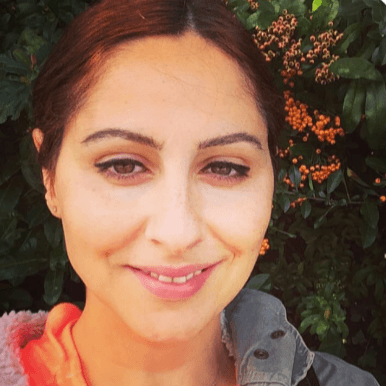
Jul 18, 2024
|
12 min read
Let your IT Business Analyst resume analyze the job market: Essential tips to highlight your skills, experience, and achievements to stand out and land your dream role in the tech industry.
Rated by 348 people
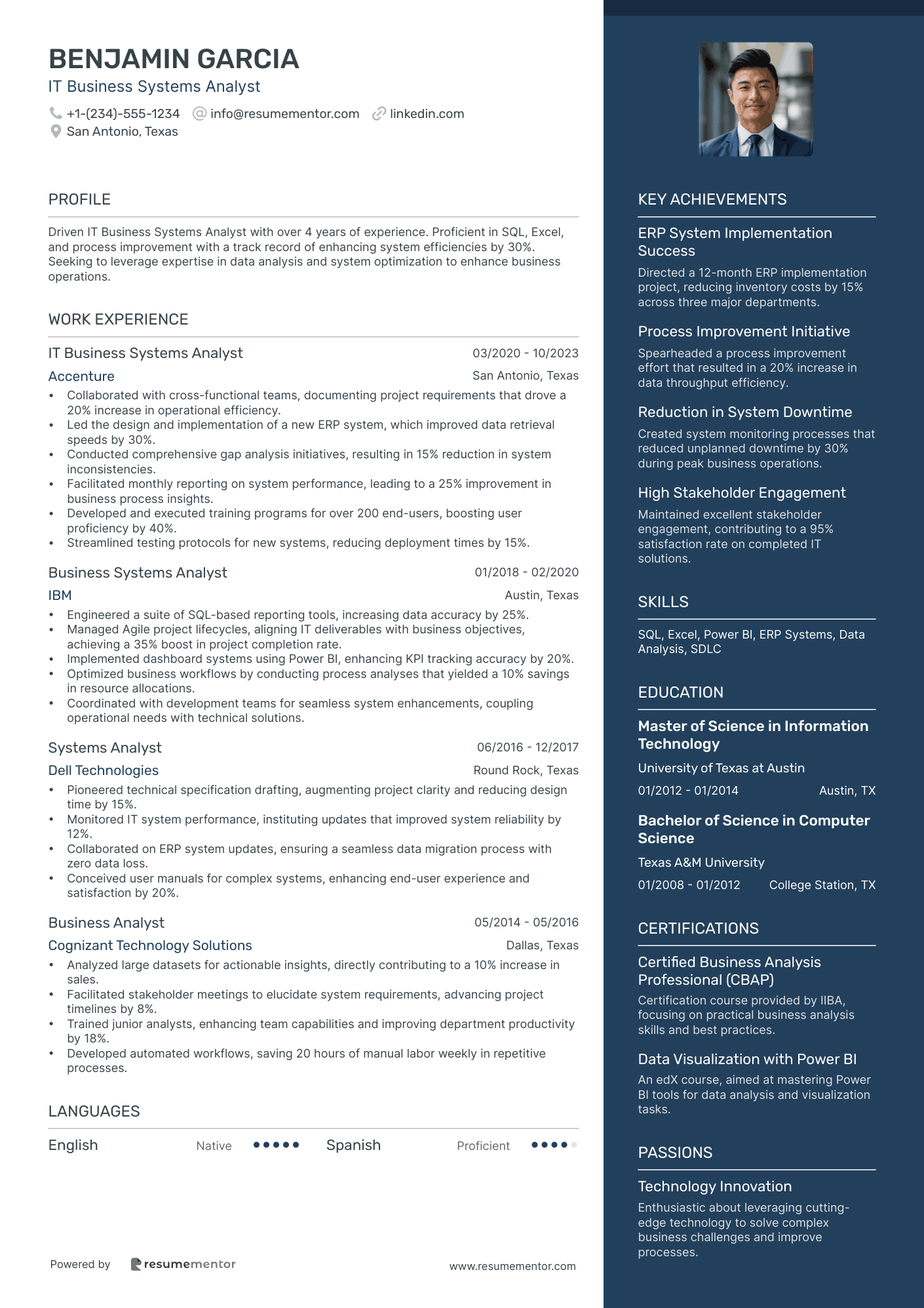
IT Business Systems Analyst
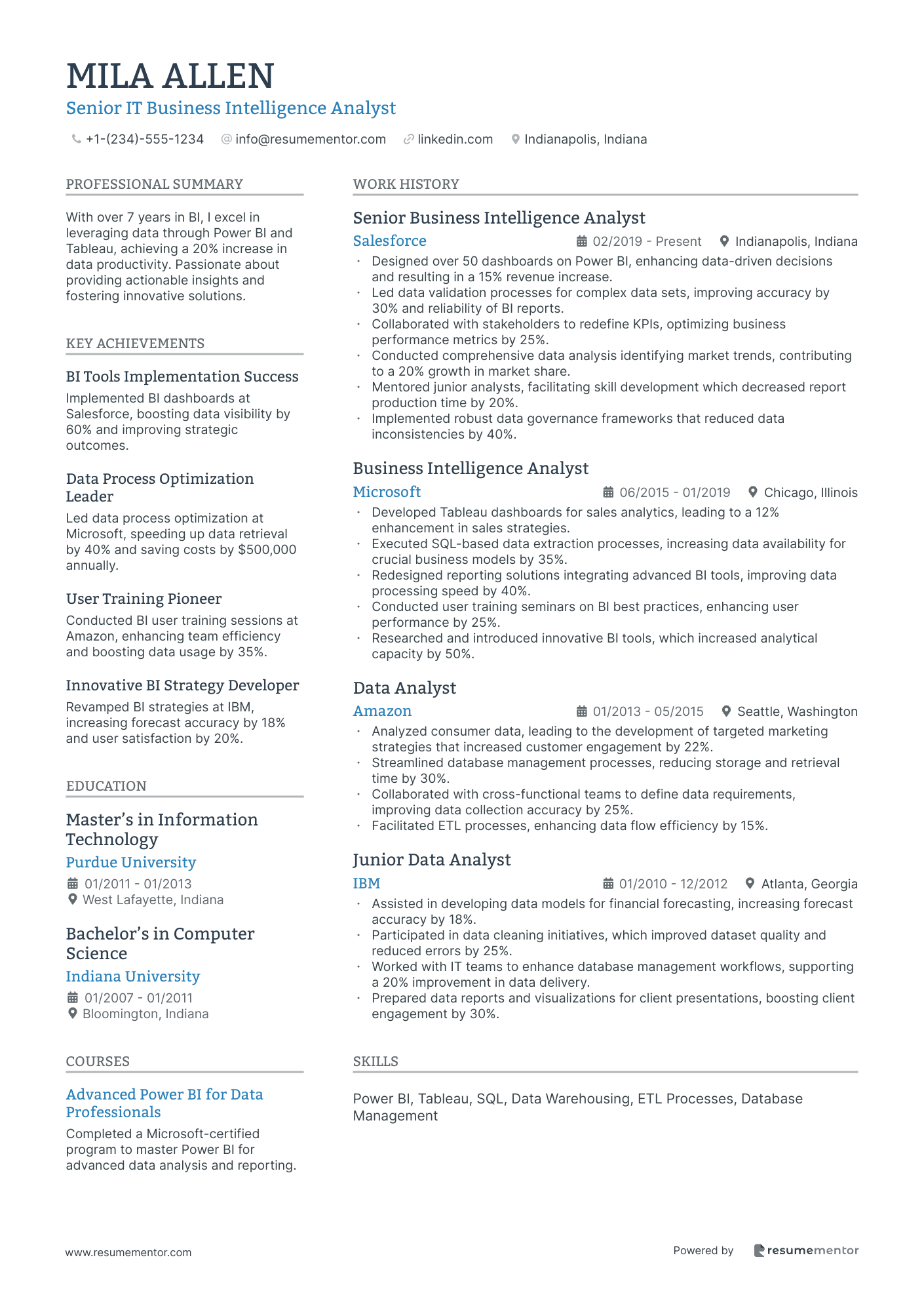
Senior IT Business Intelligence Analyst
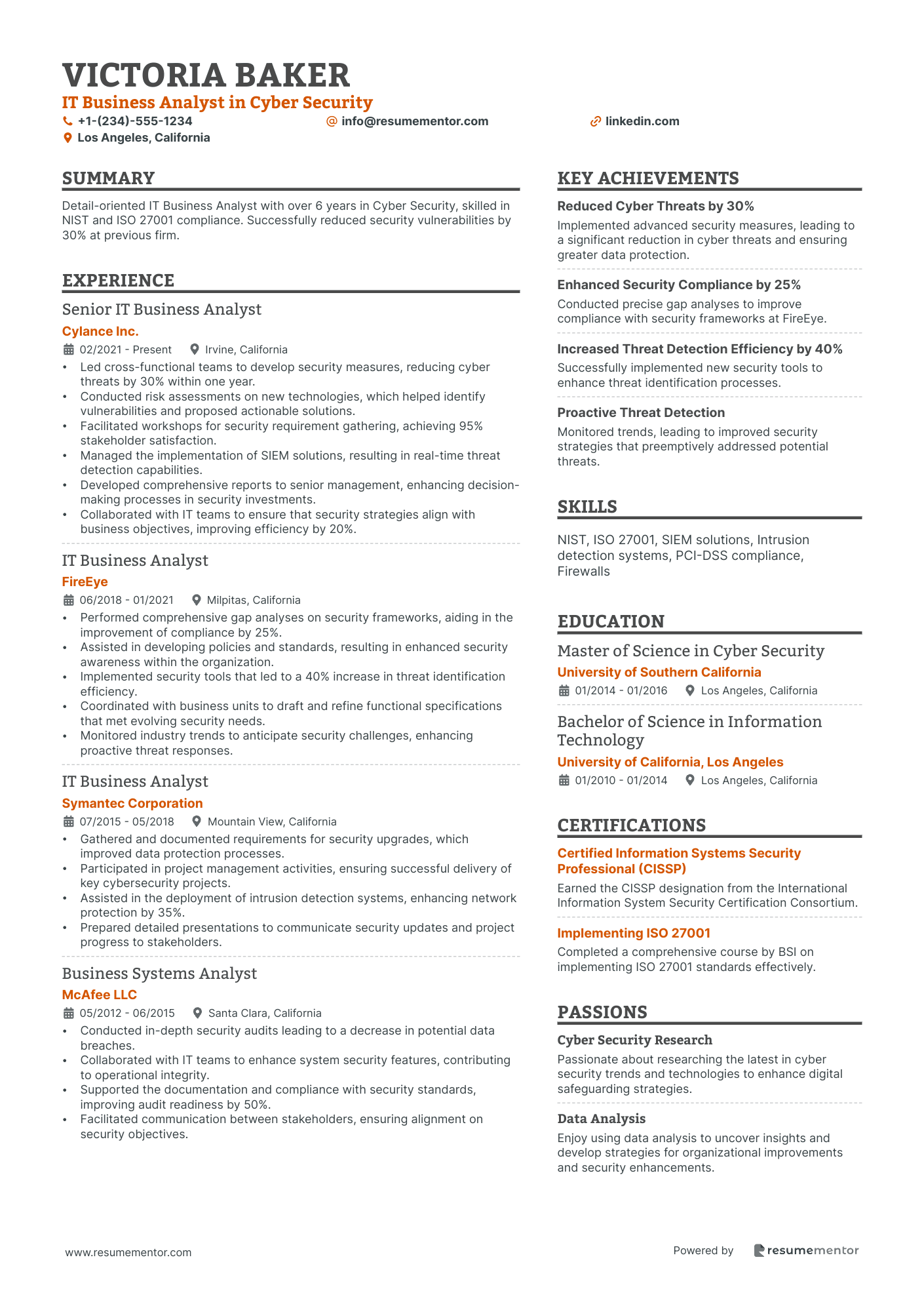
IT Business Analyst in Cyber Security
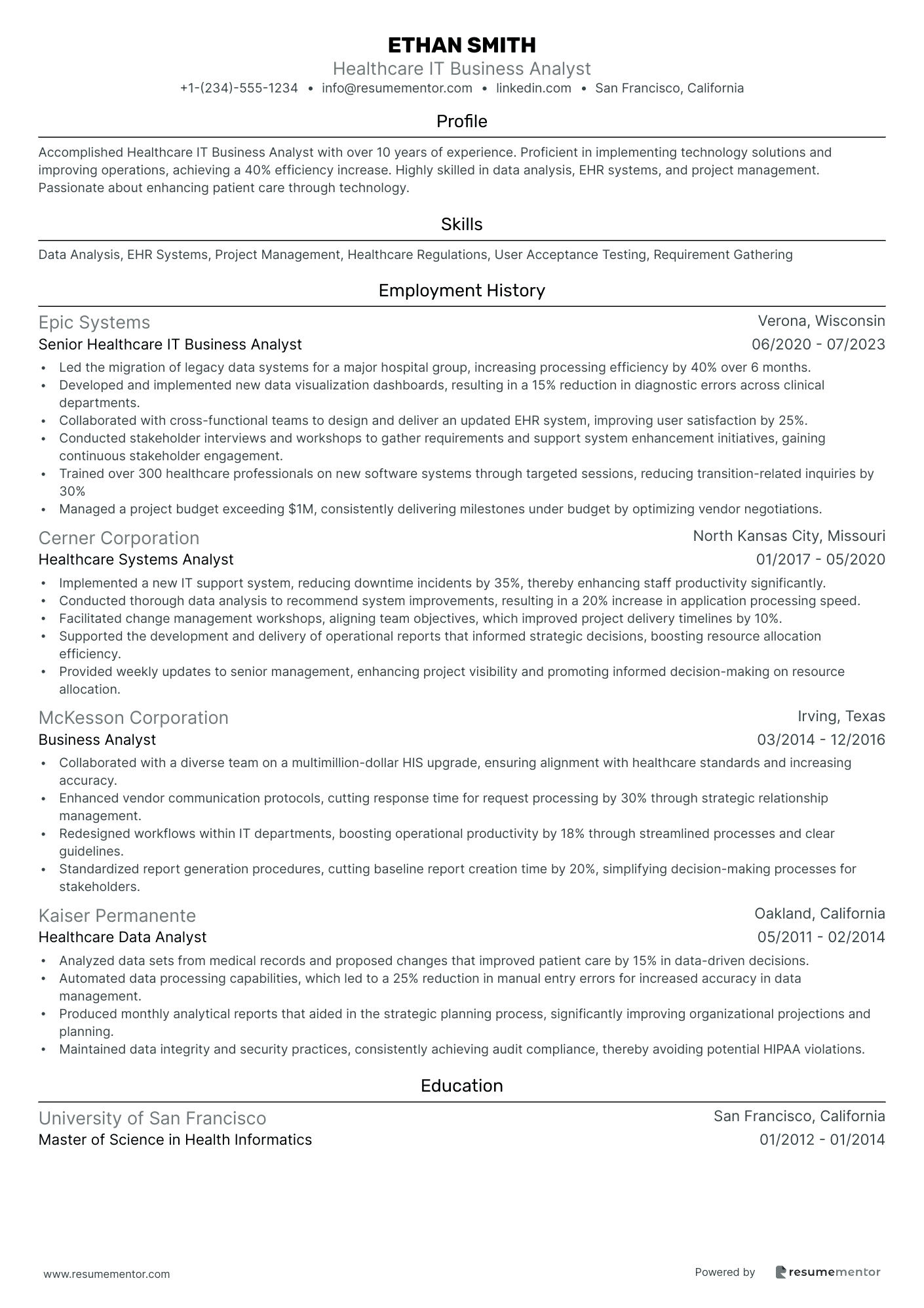
Healthcare IT Business Analyst
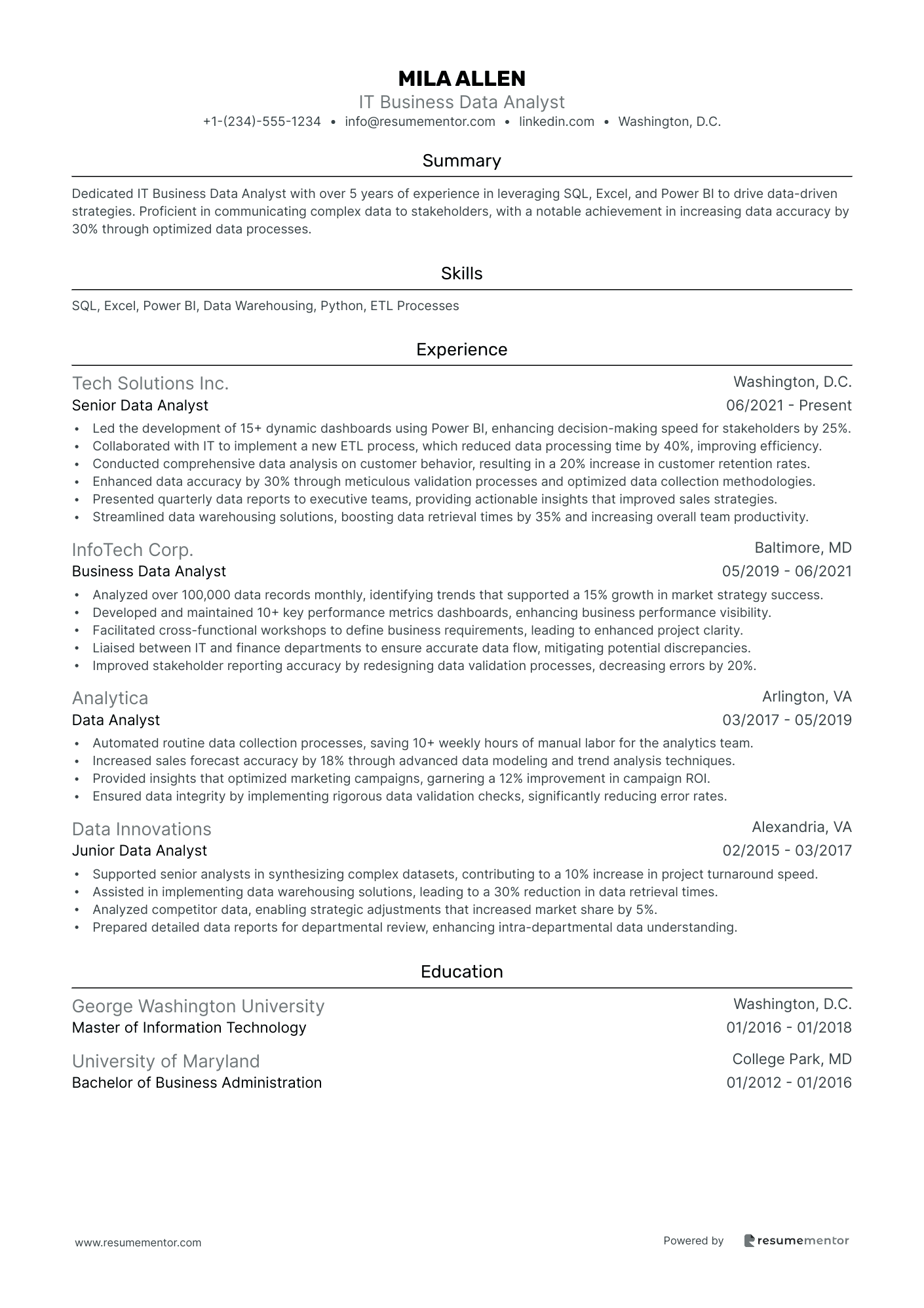
IT Business Data Analyst
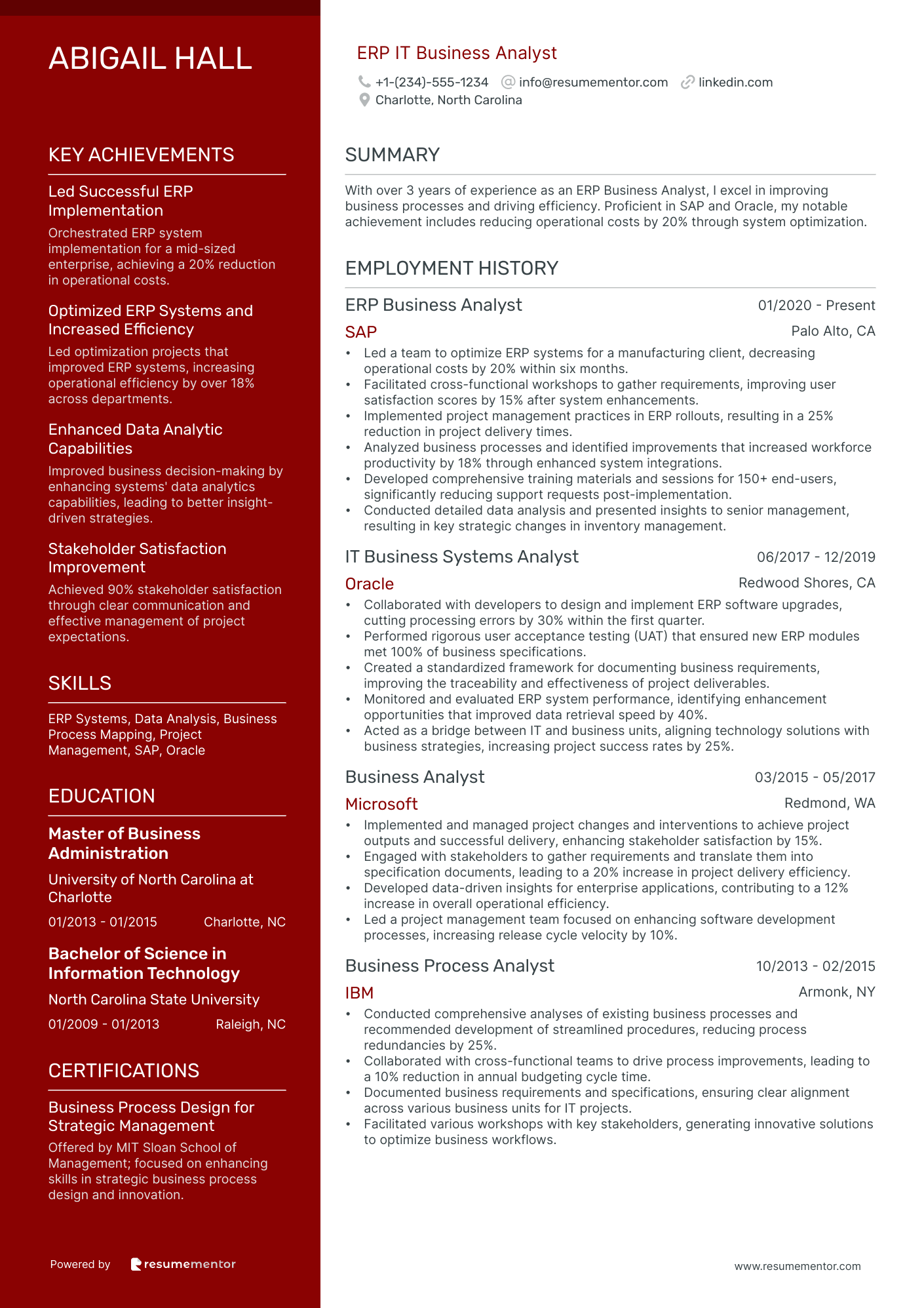
ERP IT Business Analyst
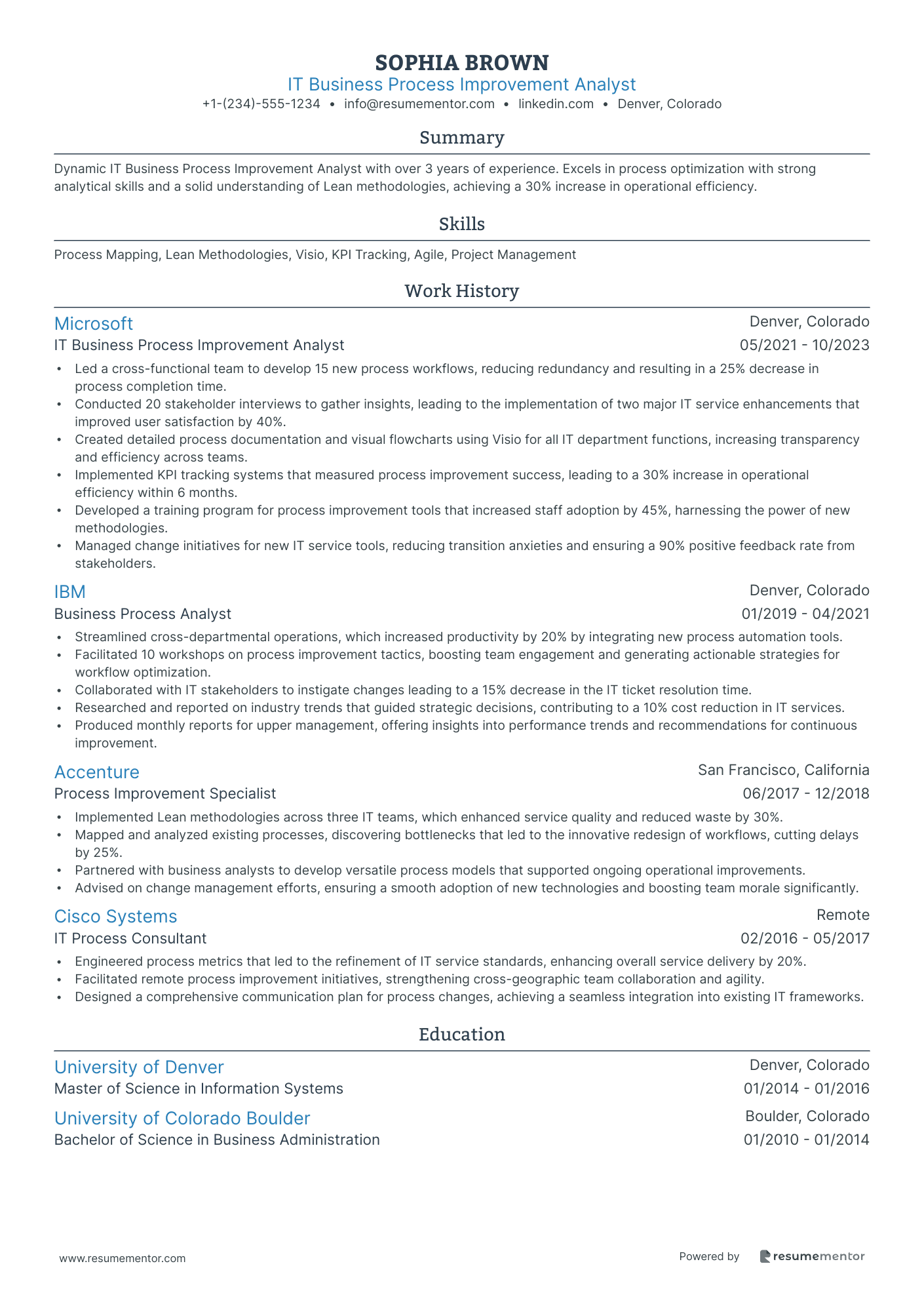
IT Business Process Improvement Analyst
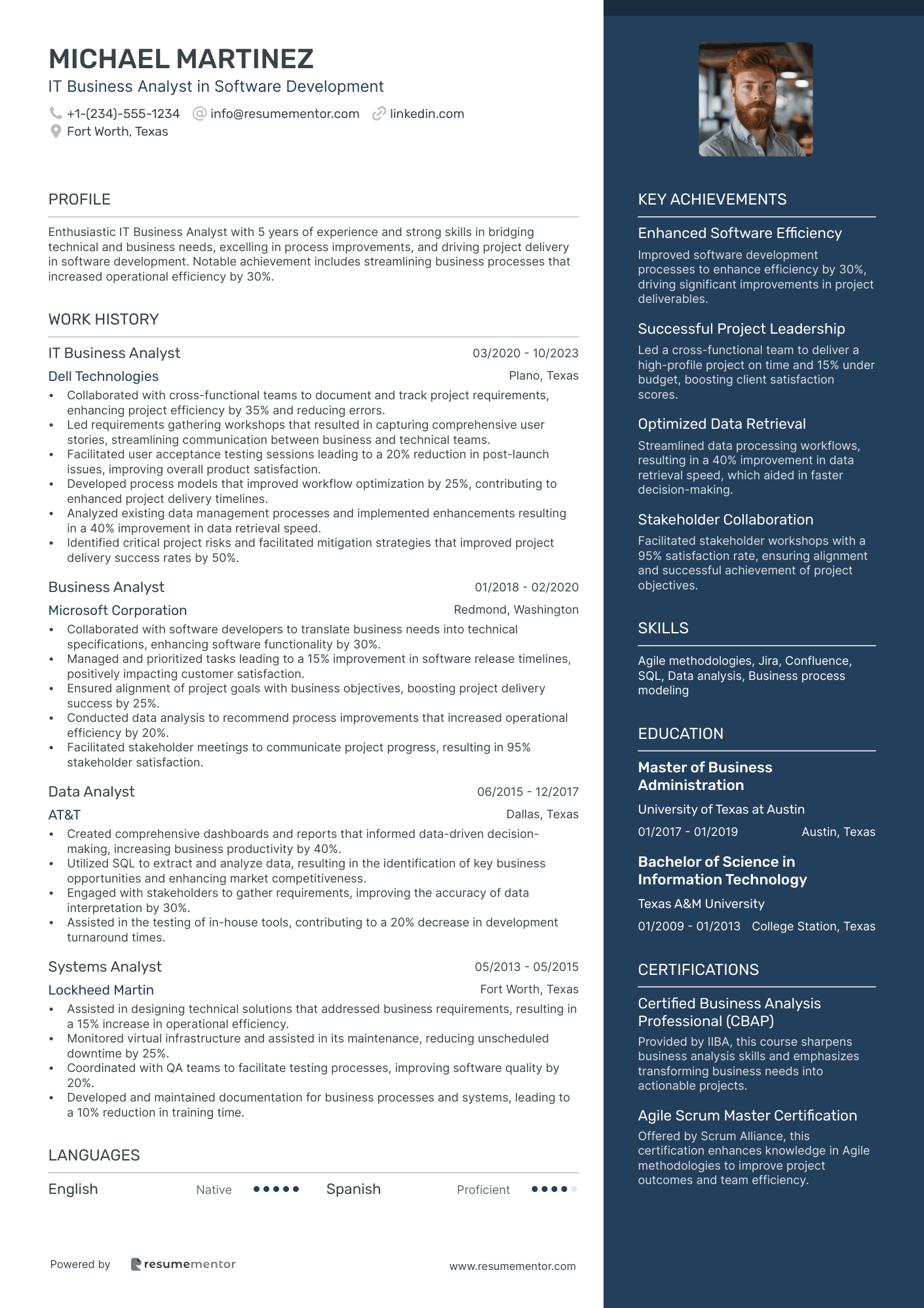
IT Business Analyst in Software Development
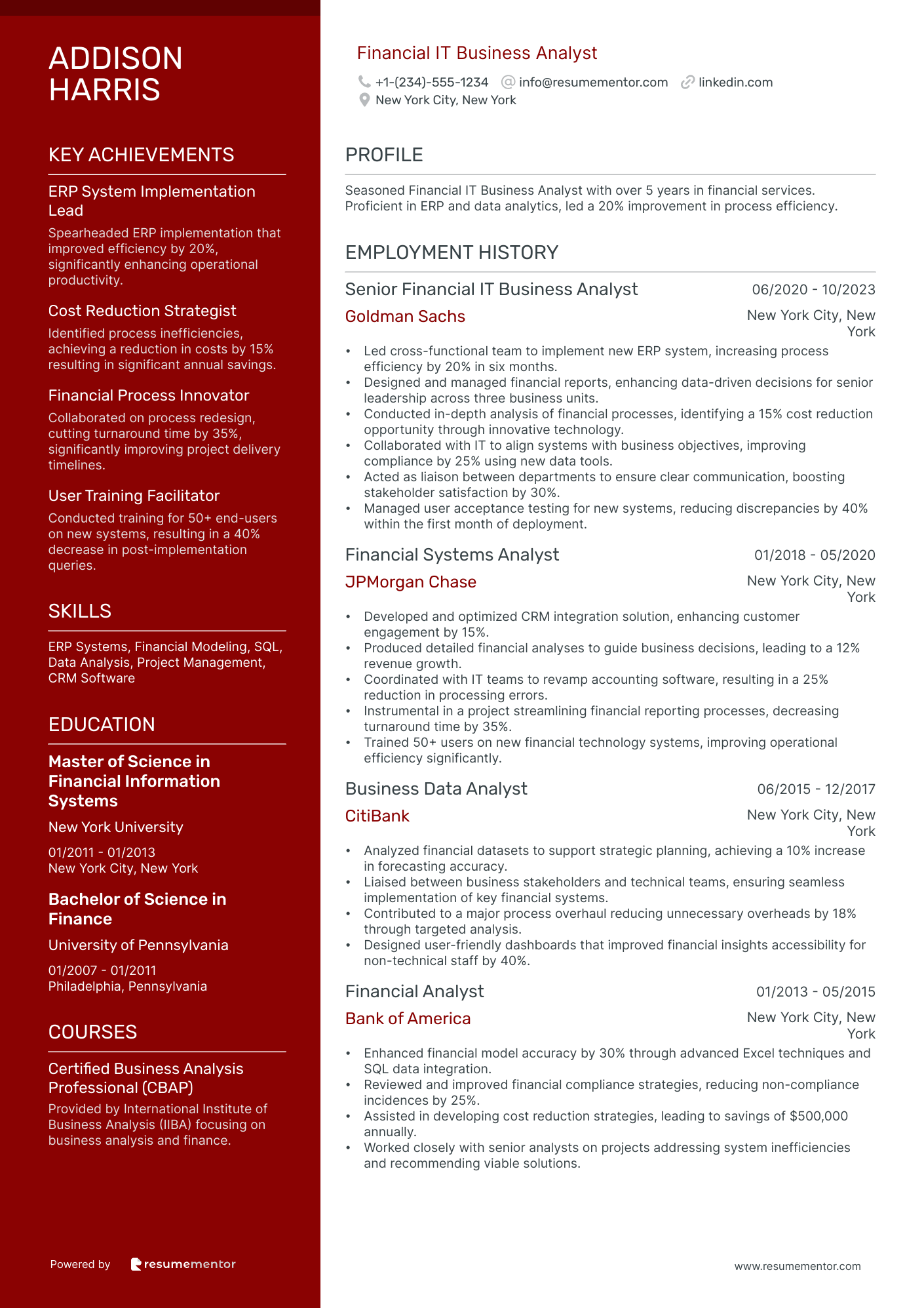
Financial IT Business Analyst

IT Business Analyst in Infrastructure Management

IT Business Systems Analyst resume sample
- •Collaborated with cross-functional teams, documenting project requirements that drove a 20% increase in operational efficiency.
- •Led the design and implementation of a new ERP system, which improved data retrieval speeds by 30%.
- •Conducted comprehensive gap analysis initiatives, resulting in 15% reduction in system inconsistencies.
- •Facilitated monthly reporting on system performance, leading to a 25% improvement in business process insights.
- •Developed and executed training programs for over 200 end-users, boosting user proficiency by 40%.
- •Streamlined testing protocols for new systems, reducing deployment times by 15%.
- •Engineered a suite of SQL-based reporting tools, increasing data accuracy by 25%.
- •Managed Agile project lifecycles, aligning IT deliverables with business objectives, achieving a 35% boost in project completion rate.
- •Implemented dashboard systems using Power BI, enhancing KPI tracking accuracy by 20%.
- •Optimized business workflows by conducting process analyses that yielded a 10% savings in resource allocations.
- •Coordinated with development teams for seamless system enhancements, coupling operational needs with technical solutions.
- •Pioneered technical specification drafting, augmenting project clarity and reducing design time by 15%.
- •Monitored IT system performance, instituting updates that improved system reliability by 12%.
- •Collaborated on ERP system updates, ensuring a seamless data migration process with zero data loss.
- •Conceived user manuals for complex systems, enhancing end-user experience and satisfaction by 20%.
- •Analyzed large datasets for actionable insights, directly contributing to a 10% increase in sales.
- •Facilitated stakeholder meetings to elucidate system requirements, advancing project timelines by 8%.
- •Trained junior analysts, enhancing team capabilities and improving department productivity by 18%.
- •Developed automated workflows, saving 20 hours of manual labor weekly in repetitive processes.
Senior IT Business Intelligence Analyst resume sample
- •Designed over 50 dashboards on Power BI, enhancing data-driven decisions and resulting in a 15% revenue increase.
- •Led data validation processes for complex data sets, improving accuracy by 30% and reliability of BI reports.
- •Collaborated with stakeholders to redefine KPIs, optimizing business performance metrics by 25%.
- •Conducted comprehensive data analysis identifying market trends, contributing to a 20% growth in market share.
- •Mentored junior analysts, facilitating skill development which decreased report production time by 20%.
- •Implemented robust data governance frameworks that reduced data inconsistencies by 40%.
- •Developed Tableau dashboards for sales analytics, leading to a 12% enhancement in sales strategies.
- •Executed SQL-based data extraction processes, increasing data availability for crucial business models by 35%.
- •Redesigned reporting solutions integrating advanced BI tools, improving data processing speed by 40%.
- •Conducted user training seminars on BI best practices, enhancing user performance by 25%.
- •Researched and introduced innovative BI tools, which increased analytical capacity by 50%.
- •Analyzed consumer data, leading to the development of targeted marketing strategies that increased customer engagement by 22%.
- •Streamlined database management processes, reducing storage and retrieval time by 30%.
- •Collaborated with cross-functional teams to define data requirements, improving data collection accuracy by 25%.
- •Facilitated ETL processes, enhancing data flow efficiency by 15%.
- •Assisted in developing data models for financial forecasting, increasing forecast accuracy by 18%.
- •Participated in data cleaning initiatives, which improved dataset quality and reduced errors by 25%.
- •Worked with IT teams to enhance database management workflows, supporting a 20% improvement in data delivery.
- •Prepared data reports and visualizations for client presentations, boosting client engagement by 30%.
IT Business Analyst in Cyber Security resume sample
- •Led cross-functional teams to develop security measures, reducing cyber threats by 30% within one year.
- •Conducted risk assessments on new technologies, which helped identify vulnerabilities and proposed actionable solutions.
- •Facilitated workshops for security requirement gathering, achieving 95% stakeholder satisfaction.
- •Managed the implementation of SIEM solutions, resulting in real-time threat detection capabilities.
- •Developed comprehensive reports to senior management, enhancing decision-making processes in security investments.
- •Collaborated with IT teams to ensure that security strategies align with business objectives, improving efficiency by 20%.
- •Performed comprehensive gap analyses on security frameworks, aiding in the improvement of compliance by 25%.
- •Assisted in developing policies and standards, resulting in enhanced security awareness within the organization.
- •Implemented security tools that led to a 40% increase in threat identification efficiency.
- •Coordinated with business units to draft and refine functional specifications that met evolving security needs.
- •Monitored industry trends to anticipate security challenges, enhancing proactive threat responses.
- •Gathered and documented requirements for security upgrades, which improved data protection processes.
- •Participated in project management activities, ensuring successful delivery of key cybersecurity projects.
- •Assisted in the deployment of intrusion detection systems, enhancing network protection by 35%.
- •Prepared detailed presentations to communicate security updates and project progress to stakeholders.
- •Conducted in-depth security audits leading to a decrease in potential data breaches.
- •Collaborated with IT teams to enhance system security features, contributing to operational integrity.
- •Supported the documentation and compliance with security standards, improving audit readiness by 50%.
- •Facilitated communication between stakeholders, ensuring alignment on security objectives.
Healthcare IT Business Analyst resume sample
- •Led the migration of legacy data systems for a major hospital group, increasing processing efficiency by 40% over 6 months.
- •Developed and implemented new data visualization dashboards, resulting in a 15% reduction in diagnostic errors across clinical departments.
- •Collaborated with cross-functional teams to design and deliver an updated EHR system, improving user satisfaction by 25%.
- •Conducted stakeholder interviews and workshops to gather requirements and support system enhancement initiatives, gaining continuous stakeholder engagement.
- •Trained over 300 healthcare professionals on new software systems through targeted sessions, reducing transition-related inquiries by 30%
- •Managed a project budget exceeding $1M, consistently delivering milestones under budget by optimizing vendor negotiations.
- •Implemented a new IT support system, reducing downtime incidents by 35%, thereby enhancing staff productivity significantly.
- •Conducted thorough data analysis to recommend system improvements, resulting in a 20% increase in application processing speed.
- •Facilitated change management workshops, aligning team objectives, which improved project delivery timelines by 10%.
- •Supported the development and delivery of operational reports that informed strategic decisions, boosting resource allocation efficiency.
- •Provided weekly updates to senior management, enhancing project visibility and promoting informed decision-making on resource allocation.
- •Collaborated with a diverse team on a multimillion-dollar HIS upgrade, ensuring alignment with healthcare standards and increasing accuracy.
- •Enhanced vendor communication protocols, cutting response time for request processing by 30% through strategic relationship management.
- •Redesigned workflows within IT departments, boosting operational productivity by 18% through streamlined processes and clear guidelines.
- •Standardized report generation procedures, cutting baseline report creation time by 20%, simplifying decision-making processes for stakeholders.
- •Analyzed data sets from medical records and proposed changes that improved patient care by 15% in data-driven decisions.
- •Automated data processing capabilities, which led to a 25% reduction in manual entry errors for increased accuracy in data management.
- •Produced monthly analytical reports that aided in the strategic planning process, significantly improving organizational projections and planning.
- •Maintained data integrity and security practices, consistently achieving audit compliance, thereby avoiding potential HIPAA violations.
IT Business Data Analyst resume sample
- •Led the development of 15+ dynamic dashboards using Power BI, enhancing decision-making speed for stakeholders by 25%.
- •Collaborated with IT to implement a new ETL process, which reduced data processing time by 40%, improving efficiency.
- •Conducted comprehensive data analysis on customer behavior, resulting in a 20% increase in customer retention rates.
- •Enhanced data accuracy by 30% through meticulous validation processes and optimized data collection methodologies.
- •Presented quarterly data reports to executive teams, providing actionable insights that improved sales strategies.
- •Streamlined data warehousing solutions, boosting data retrieval times by 35% and increasing overall team productivity.
- •Analyzed over 100,000 data records monthly, identifying trends that supported a 15% growth in market strategy success.
- •Developed and maintained 10+ key performance metrics dashboards, enhancing business performance visibility.
- •Facilitated cross-functional workshops to define business requirements, leading to enhanced project clarity.
- •Liaised between IT and finance departments to ensure accurate data flow, mitigating potential discrepancies.
- •Improved stakeholder reporting accuracy by redesigning data validation processes, decreasing errors by 20%.
- •Automated routine data collection processes, saving 10+ weekly hours of manual labor for the analytics team.
- •Increased sales forecast accuracy by 18% through advanced data modeling and trend analysis techniques.
- •Provided insights that optimized marketing campaigns, garnering a 12% improvement in campaign ROI.
- •Ensured data integrity by implementing rigorous data validation checks, significantly reducing error rates.
- •Supported senior analysts in synthesizing complex datasets, contributing to a 10% increase in project turnaround speed.
- •Assisted in implementing data warehousing solutions, leading to a 30% reduction in data retrieval times.
- •Analyzed competitor data, enabling strategic adjustments that increased market share by 5%.
- •Prepared detailed data reports for departmental review, enhancing intra-departmental data understanding.
ERP IT Business Analyst resume sample
- •Led a team to optimize ERP systems for a manufacturing client, decreasing operational costs by 20% within six months.
- •Facilitated cross-functional workshops to gather requirements, improving user satisfaction scores by 15% after system enhancements.
- •Implemented project management practices in ERP rollouts, resulting in a 25% reduction in project delivery times.
- •Analyzed business processes and identified improvements that increased workforce productivity by 18% through enhanced system integrations.
- •Developed comprehensive training materials and sessions for 150+ end-users, significantly reducing support requests post-implementation.
- •Conducted detailed data analysis and presented insights to senior management, resulting in key strategic changes in inventory management.
- •Collaborated with developers to design and implement ERP software upgrades, cutting processing errors by 30% within the first quarter.
- •Performed rigorous user acceptance testing (UAT) that ensured new ERP modules met 100% of business specifications.
- •Created a standardized framework for documenting business requirements, improving the traceability and effectiveness of project deliverables.
- •Monitored and evaluated ERP system performance, identifying enhancement opportunities that improved data retrieval speed by 40%.
- •Acted as a bridge between IT and business units, aligning technology solutions with business strategies, increasing project success rates by 25%.
- •Implemented and managed project changes and interventions to achieve project outputs and successful delivery, enhancing stakeholder satisfaction by 15%.
- •Engaged with stakeholders to gather requirements and translate them into specification documents, leading to a 20% increase in project delivery efficiency.
- •Developed data-driven insights for enterprise applications, contributing to a 12% increase in overall operational efficiency.
- •Led a project management team focused on enhancing software development processes, increasing release cycle velocity by 10%.
- •Conducted comprehensive analyses of existing business processes and recommended development of streamlined procedures, reducing process redundancies by 25%.
- •Collaborated with cross-functional teams to drive process improvements, leading to a 10% reduction in annual budgeting cycle time.
- •Documented business requirements and specifications, ensuring clear alignment across various business units for IT projects.
- •Facilitated various workshops with key stakeholders, generating innovative solutions to optimize business workflows.
IT Business Process Improvement Analyst resume sample
- •Led a cross-functional team to develop 15 new process workflows, reducing redundancy and resulting in a 25% decrease in process completion time.
- •Conducted 20 stakeholder interviews to gather insights, leading to the implementation of two major IT service enhancements that improved user satisfaction by 40%.
- •Created detailed process documentation and visual flowcharts using Visio for all IT department functions, increasing transparency and efficiency across teams.
- •Implemented KPI tracking systems that measured process improvement success, leading to a 30% increase in operational efficiency within 6 months.
- •Developed a training program for process improvement tools that increased staff adoption by 45%, harnessing the power of new methodologies.
- •Managed change initiatives for new IT service tools, reducing transition anxieties and ensuring a 90% positive feedback rate from stakeholders.
- •Streamlined cross-departmental operations, which increased productivity by 20% by integrating new process automation tools.
- •Facilitated 10 workshops on process improvement tactics, boosting team engagement and generating actionable strategies for workflow optimization.
- •Collaborated with IT stakeholders to instigate changes leading to a 15% decrease in the IT ticket resolution time.
- •Researched and reported on industry trends that guided strategic decisions, contributing to a 10% cost reduction in IT services.
- •Produced monthly reports for upper management, offering insights into performance trends and recommendations for continuous improvement.
- •Implemented Lean methodologies across three IT teams, which enhanced service quality and reduced waste by 30%.
- •Mapped and analyzed existing processes, discovering bottlenecks that led to the innovative redesign of workflows, cutting delays by 25%.
- •Partnered with business analysts to develop versatile process models that supported ongoing operational improvements.
- •Advised on change management efforts, ensuring a smooth adoption of new technologies and boosting team morale significantly.
- •Engineered process metrics that led to the refinement of IT service standards, enhancing overall service delivery by 20%.
- •Facilitated remote process improvement initiatives, strengthening cross-geographic team collaboration and agility.
- •Designed a comprehensive communication plan for process changes, achieving a seamless integration into existing IT frameworks.
IT Business Analyst in Software Development resume sample
- •Collaborated with cross-functional teams to document and track project requirements, enhancing project efficiency by 35% and reducing errors.
- •Led requirements gathering workshops that resulted in capturing comprehensive user stories, streamlining communication between business and technical teams.
- •Facilitated user acceptance testing sessions leading to a 20% reduction in post-launch issues, improving overall product satisfaction.
- •Developed process models that improved workflow optimization by 25%, contributing to enhanced project delivery timelines.
- •Analyzed existing data management processes and implemented enhancements resulting in a 40% improvement in data retrieval speed.
- •Identified critical project risks and facilitated mitigation strategies that improved project delivery success rates by 50%.
- •Collaborated with software developers to translate business needs into technical specifications, enhancing software functionality by 30%.
- •Managed and prioritized tasks leading to a 15% improvement in software release timelines, positively impacting customer satisfaction.
- •Ensured alignment of project goals with business objectives, boosting project delivery success by 25%.
- •Conducted data analysis to recommend process improvements that increased operational efficiency by 20%.
- •Facilitated stakeholder meetings to communicate project progress, resulting in 95% stakeholder satisfaction.
- •Created comprehensive dashboards and reports that informed data-driven decision-making, increasing business productivity by 40%.
- •Utilized SQL to extract and analyze data, resulting in the identification of key business opportunities and enhancing market competitiveness.
- •Engaged with stakeholders to gather requirements, improving the accuracy of data interpretation by 30%.
- •Assisted in the testing of in-house tools, contributing to a 20% decrease in development turnaround times.
- •Assisted in designing technical solutions that addressed business requirements, resulting in a 15% increase in operational efficiency.
- •Monitored virtual infrastructure and assisted in its maintenance, reducing unscheduled downtime by 25%.
- •Coordinated with QA teams to facilitate testing processes, improving software quality by 20%.
- •Developed and maintained documentation for business processes and systems, leading to a 10% reduction in training time.
Financial IT Business Analyst resume sample
- •Led cross-functional team to implement new ERP system, increasing process efficiency by 20% in six months.
- •Designed and managed financial reports, enhancing data-driven decisions for senior leadership across three business units.
- •Conducted in-depth analysis of financial processes, identifying a 15% cost reduction opportunity through innovative technology.
- •Collaborated with IT to align systems with business objectives, improving compliance by 25% using new data tools.
- •Acted as liaison between departments to ensure clear communication, boosting stakeholder satisfaction by 30%.
- •Managed user acceptance testing for new systems, reducing discrepancies by 40% within the first month of deployment.
- •Developed and optimized CRM integration solution, enhancing customer engagement by 15%.
- •Produced detailed financial analyses to guide business decisions, leading to a 12% revenue growth.
- •Coordinated with IT teams to revamp accounting software, resulting in a 25% reduction in processing errors.
- •Instrumental in a project streamlining financial reporting processes, decreasing turnaround time by 35%.
- •Trained 50+ users on new financial technology systems, improving operational efficiency significantly.
- •Analyzed financial datasets to support strategic planning, achieving a 10% increase in forecasting accuracy.
- •Liaised between business stakeholders and technical teams, ensuring seamless implementation of key financial systems.
- •Contributed to a major process overhaul reducing unnecessary overheads by 18% through targeted analysis.
- •Designed user-friendly dashboards that improved financial insights accessibility for non-technical staff by 40%.
- •Enhanced financial model accuracy by 30% through advanced Excel techniques and SQL data integration.
- •Reviewed and improved financial compliance strategies, reducing non-compliance incidences by 25%.
- •Assisted in developing cost reduction strategies, leading to savings of $500,000 annually.
- •Worked closely with senior analysts on projects addressing system inefficiencies and recommending viable solutions.
IT Business Analyst in Infrastructure Management resume sample
- •Led the successful implementation of a major infrastructure project, enhancing system uptime by 20% within budget and timeline.
- •Analyzed business requirements for over 50 stakeholders, resulting in tailored solutions that improved user satisfaction by 15%.
- •Conducted risk assessments and facilitated workshops leading to a streamlined decision-making process and a 25% reduction in project delays.
- •Collaborated with cross-functional teams to develop use cases, improving infrastructure efficiency and lowering operational costs by 10%.
- •Produced comprehensive project documentation and user acceptance plans, contributing to a 30% increase in project approval rates.
- •Led project status meetings and generated reports that improved management insight, resulting in better resource allocation and enhanced outcomes.
- •Facilitated stakeholder meetings and compiled requirements documents, leading to 40% improvement in infrastructure project clarity.
- •Conducted feasibility studies for new technology integrations, significantly reducing implementation risks and lowering costs by 18%.
- •Developed process maps for critical enterprise systems, enhancing team understanding and improving deployment speed by 16%.
- •Worked closely with IT teams, ensuring thorough testing, resulting in zero post-launch critical issues in the last two releases.
- •Monitored infrastructure project progress against KPIs, optimizing resources, and delivering projects ahead of schedule by 10%.
- •Managed cross-functional collaborations for server upgrades, improving processing power by 25% and enhancing client service delivery.
- •Created detailed technical specifications ensuring aligned business processes, which decreased incidents related to misconfigurations by 30%.
- •Regularly engaged with technical teams to evaluate and rectify system vulnerabilities, leading to heightened network security protocols.
- •Oversaw training documentation and sessions, resulting in 35% more effective use of new IT systems among end-users.
- •Gathered and analyzed requirements for database management projects, leading to 20% faster query handling and processing.
- •Contributed to designing cloud service strategies, allowing for more scalable solutions resulting in increased storage capabilities.
- •Led usability testing initiatives, facilitating improvements in system user interface and reducing user errors by 22%.
- •Generated reports on infrastructure performance metrics for executive team, aiding in strategic planning and technology investments.
Creating a standout IT Business Analyst resume can feel like unraveling a complex algorithm, yet it’s crucial for opening doors to new opportunities. Your resume serves as more than just a document; it’s a showcase of your technical expertise and analytical skills, giving potential employers a clear picture of your capabilities. You might find it challenging to communicate your value effectively, especially when balancing technical details with measurable achievements.
Here’s where using a resume template can make a huge difference. A structured format ensures that key information doesn’t get lost and helps present your experience cohesively. If you explore different templates, you can find one that perfectly matches your style and needs, making your strengths clear at a glance. Remember, recruiters often spend only seconds skimming each resume, so having a precise and polished format is essential.
Your resume should weave your experience into the role you’re aiming for, guiding the reader smoothly through your professional journey. Think of it as your personal map in the competitive job market—a tool that helps you navigate and stand out among seasoned analysts.
As you fine-tune your resume, concentrate on what makes you unique. Let's explore the steps to craft a compelling resume that highlights your strengths and propels you toward your next big opportunity.
Key Takeaways
- Creating a standout IT Business Analyst resume involves showcasing technical expertise, analytical skills, and using a structured format like a template to make key information easily accessible.
- Key sections of the resume should include a professional summary, skills, work experience with quantifiable achievements, education, and technical skills relevant to the job.
- Choosing the right resume format, such as chronological, and paying attention to font choice, file type, and margins can enhance readability and presentation.
- The experience section should highlight achievements and the impact of your role, using dynamic verbs and tailoring content to align with specific job descriptions.
- Additional sections like certifications, volunteer experience, and professional affiliations can enrich your profile and provide extra insights into your background and interests.
What to focus on when writing your IT business analyst resume
An IT business analyst resume should clearly demonstrate your skill in aligning IT and business goals to drive project success. This includes showing how your talents in data analysis, project management, and problem-solving make you a valuable asset. By emphasizing your ability to understand complex technical needs and convert them into actionable business solutions, you'll stand out.
How to structure your IT business analyst resume
- Contact Information — Start with your full name, phone number, professional email, and LinkedIn profile to ensure recruiters can easily connect with you. Avoid using unprofessional email addresses. Make sure your LinkedIn profile is up to date since potential employers often reference it to gain more insight into your professional history.
- Professional Summary — Write a brief statement capturing your experience and strengths, such as data analysis and stakeholder engagement, which highlight your IT project management skills. This section should reflect your unique value proposition, making it clear why you're the perfect fit for the role. Link your summary to tangible achievements or learning experiences that have shaped your career, providing a strong impression of your capabilities.
- Skills — Focus on key competencies like requirements gathering and business process modeling, as well as your proficiency with data analysis tools and agile methodologies. Including both soft skills, like communication and analytical thinking, and technical skills, such as SQL and data visualization, showcases a well-rounded professional profile.
- Work Experience — Describe your previous roles by detailing accomplishments and contributions to IT projects, using quantifiable achievements to demonstrate your impact. Highlight specific projects where you made a difference, as well as any leadership roles or cross-functional collaborations that underscore your versatility. This creates a narrative of consistent growth and capability within your field.
- Education — Include your degree(s) and any relevant certifications, like CBAP or CCBA, that complement your experience. Ensure that your educational background supports your career path, mentioning honors or relevant coursework when applicable. This bolsters your technical foundation and commitment to continual learning and professional growth.
- Technical Skills — List specific tools and software you’re proficient in, such as SQL, Tableau, JIRA, or Microsoft Power BI, to highlight your technical expertise. These should reflect the latest industry standards and align with the requirements of your targeted roles, aiding recruiters in identifying your potential to add immediate value.
To further enhance your profile, consider adding sections like Certifications, Volunteer Experience, or Professional Affiliations. These can provide additional insights into your background and interests. Below, we'll cover each section more in-depth to refine your resume format, ensuring an impactful presentation of your qualifications.
Which resume format to choose
For an IT business analyst resume, choosing the right format is crucial because it helps highlight your experience in a way that's easily digestible for potential employers. A chronological format is particularly effective here. This structure allows you to present your career journey step by step, focusing on the growth and stability you've demonstrated in the IT industry. This format naturally segues into making other key decisions like font selection, ensuring your entire resume is cohesive and professional.
Font choice can significantly influence the first impression your resume makes. Opt for modern fonts like Raleway, Montserrat, or Chivo to add a fresh twist while maintaining professionalism. These fonts offer a contemporary feel without being overwhelming, making your information stand out clearly. Your choice of font plays a subtle yet important role in keeping your resume reader-friendly and aesthetically pleasing.
File type is another crucial aspect that can make a big difference in how your resume is received. Always save your resume as a PDF. This ensures that the formatting you worked hard on remains intact across different devices and operating systems. PDFs are dependable, offering consistency that you need when applying for positions where attention to detail is key.
Margin settings might seem like a minor detail, but they contribute significantly to the overall readability of your resume. Keeping one-inch margins on all sides allows for a clean and organized appearance. This provides necessary white space, making it easier for employers to skim through your information quickly.
By carefully considering each of these elements—format, font, file type, and margins—you craft a professional and effective IT business analyst resume that showcases your qualifications and makes a strong impression.
How to write a quantifiable resume experience section
Creating an effective IT Business Analyst experience section is crucial for making a strong impression on potential employers. Start by structuring this part of your resume to highlight your achievements and the impact you made in your roles. Arrange your jobs in reverse chronological order, including the last 10-15 years of relevant work experience. This ensures that you focus on positions directly related to a Business Analyst role, helping employers quickly see your value. Tailoring your resume to each job ad is essential; this means aligning your experience with the keywords and skills mentioned in the description. By using dynamic action verbs like "implemented," "analyzed," "developed," and "improved," you convey a sense of effectiveness and initiative, which are vital traits for an IT Business Analyst.
Here is an example that brings this approach to life:
- •Increased operational efficiency by 30% by implementing new workflows.
- •Led a cross-functional team to cut project delivery times by 20%, aligning with strategic goals.
- •Conducted data analysis that led to a $500,000 yearly cost savings in the IT department.
- •Boosted user satisfaction scores by 25% by integrating user feedback into system updates.
This example ties together various aspects of the IT Business Analyst role, showcasing achievements that demonstrate both skill and impact. Each bullet point flows smoothly into the next, connecting responsibilities like process improvement, teamwork, and data analysis. By focusing on clear, quantifiable results, these entries offer a cohesive picture of your capabilities. Tailoring your experience to reflect these successes helps you stand out to employers, making it clear that you are a valuable and capable candidate for the role.
Efficiency-Focused resume experience section
An efficiency-focused IT business analyst resume experience section should clearly highlight how you've made a tangible impact on the organizations you've worked for. Begin by pinpointing your significant achievements, such as projects where you enhanced processes and increased productivity. Providing concrete numbers or percentages helps illustrate the difference you've made and allows potential employers to visualize the value you can bring to their team.
Build on this by describing how you've optimized workflows and introduced cost-effective solutions, tying these improvements to specific tools or strategies you implemented. Emphasize your ability to collaborate effectively with various teams and your knack for analyzing data to uncover valuable insights. Including your proficiency with business analysis tools can further underscore your competence. Throughout this section, aim to convey a consistent track record of enhancing operations, showcasing both your analytical and strategic thinking skills.
IT Business Analyst
Tech Solutions Inc.
January 2021 - Present
- Led a team to streamline business processes, achieving a 30% increase in operational efficiency.
- Introduced a new project management tool that reduced project delivery time by 20%.
- Collaborated with IT and operations teams to develop a dashboard for real-time performance tracking, enhancing decision-making speed.
- Analyzed workflow inefficiencies and implemented solutions that saved the organization $100,000 annually.
Achievement-Focused resume experience section
An achievement-focused IT Business Analyst resume experience section should effectively showcase your expertise and the positive impact you've made in previous roles. Start by emphasizing tangible results instead of just listing duties, zeroing in on significant achievements like cost savings, streamlining processes, or enhancing customer satisfaction. Use numbers and percentages to make your accomplishments more concrete, providing prospective employers with a clear view of your capabilities.
Each bullet point should start with an engaging action verb to maintain the reader's attention and clearly convey the outcomes you achieved. Tailor your experiences to the job you are applying for, focusing on the skills and accomplishments the employer values. This tailored approach underscores your suitability for the role. Ensure your experience section reflects both your technical expertise and interpersonal skills, highlighting your ability to connect IT with business needs seamlessly.
IT Business Analyst
Acme Corp
June 2020 - Present
- Increased project efficiency by 30% through the implementation of a new data tracking system.
- Reduced software development costs by 15% by negotiating better terms with vendors.
- Led a team of 10 to revamp the IT service delivery model, enhancing client satisfaction by 20%.
- Collaborated with cross-functional teams to redesign workflow processes, cutting response time by 25%.
Collaboration-Focused resume experience section
A collaboration-focused IT Business Analyst resume experience section should effectively weave together your teamwork, communication, and stakeholder engagement skills. Begin by listing your job title, workplace, and dates of employment to set the context. Then, delve into how your collaborative efforts have positively impacted projects and the organization. Use action verbs to vividly illustrate your role in team efforts, emphasizing tangible outcomes. Highlight your seamless cooperation with different departments and your use of technology to enhance communication. Describe how your skills have precisely bridged any gaps between IT and business goals, fostering a harmonious work environment.
When crafting your bullet points, keep them detailed yet concise to spotlight significant achievements and strategies you utilized to meet business objectives through collaboration. Include specific examples of projects you led or contributed to, pointing out strategies that strengthened team unity and the resultant successes. Aim to share concrete instances where your collaborative approach significantly improved project outcomes or organizational processes. By doing so, you underscore your technical proficiency along with your ability to nurture a productive and engaging team atmosphere.
IT Business Analyst
Tech Solutions Co.
June 2019 - Present
- Facilitated cross-departmental workshops that led to a 15% reduction in process bottlenecks.
- Collaborated with product development teams using Agile methods, which sped up the release cycle by 25%.
- Implemented a new communication protocol that enhanced visibility across departments, boosting task completion rates by 10%.
- Worked closely with management to align IT solutions with business goals, increasing project success rates by 20%.
Skills-Focused resume experience section
A skills-focused IT Business Analyst resume experience section should effectively highlight your specific expertise and the impact you've made in previous roles. Begin by clearly stating the focus of this section, such as "Technical Project Management" or "Data Analysis and Reporting," so potential employers can quickly grasp your area of specialization. Use powerful action verbs and incorporate quantifiable achievements to vividly depict your contributions, whether through improvements in efficiency, successful project implementations, or data-driven decision-making.
Organize each entry in reverse chronological order, starting with your job title, company name, and the duration of your role. Each entry should succinctly describe your key responsibilities and accomplishments, with an emphasis on measurable results and the value you provided. Present your tasks and achievements using bullet points to make the information easy for employers to read and understand. Keep the language direct, focusing on the skills and experiences that are most relevant to the job you are targeting.
IT Business Analyst
Tech Solutions Inc
June 2018 - July 2021
- Led the implementation of a new CRM system, boosting sales productivity by 30%.
- Worked with cross-functional teams to deliver projects on time and within budget, improving team efficiency by 20%.
- Crafted comprehensive business requirements documents for software development initiatives.
- Facilitated weekly stakeholder meetings to ensure alignment on project goals and timelines.
Write your IT business analyst resume summary section
A results-focused IT Business Analyst resume summary section should make you stand out in a crowded job market. If you have solid experience, a summary is your best choice because it highlights your career achievements and engages hiring managers. It should quickly answer who you are, what you've accomplished, and what you can bring to the table. By keeping it concise, you can pack a punch in a small space. Use active language to show confidence and include measurable successes that speak volumes.
Consider an example like this:
This example showcases specific results, clearly illustrating your impact and expertise. It sets a strong tone for the rest of your resume, inviting further interest. However, if you're new to the field, a resume objective might serve you better. Unlike a summary, objectives focus on your goals and the value you want to bring as you learn and grow. They offer a forward-looking perspective, especially useful if you're switching careers. For instance, "Aspiring IT Business Analyst eager to use analytical skills and technology insights to drive business solutions."
Both a summary and an objective serve to capture attention quickly, though they do so in different ways. A summary emphasizes past successes, while an objective is about future goals. These are distinct from a resume profile, which provides a broader career overview, or a summary of qualifications, which lists skills or accomplishments. Choose your approach based on your experience and the job you're aiming for, ensuring these few lines resonate strongly with your target role. Use this section to demonstrate clarity and readiness, making a memorable first impression.
Listing your IT business analyst skills on your resume
A skills-focused IT business analyst resume should highlight your expertise in a way that stands out. You can either create a dedicated skills section or integrate your skills into areas like your experience or summary. This approach lets you emphasize both your strengths and soft skills, such as problem-solving and communication. In contrast, hard skills are the technical abilities you've mastered, like coding or data analysis, that are critical to your role.
Incorporating your skills can effectively act as resume keywords, capturing the attention of hiring managers and applicant tracking systems. By strategically aligning your strengths and skills, your resume becomes more compelling.
Here's an example of a standalone skills section in JSON format that showcases relevant IT business analyst skills:
This skills section is effective because it consolidates the critical skills needed for an IT business analyst. Listing eight skills offers a comprehensive yet concise view, making it easy for hiring managers to evaluate your capabilities quickly.
Best hard skills to feature on your IT business analyst resume
An IT business analyst should possess hard skills that convey technical proficiency and analytical capabilities. These skills demonstrate your ability to manage IT tasks and interpret data effectively, crucial for successfully executing your role.
Hard Skills
- Data Analysis
- SQL
- Business Process Modeling
- Agile Methodologies
- Project Management
- Requirements Gathering
- User Acceptance Testing
- Software Development Lifecycle (SDLC)
- Data Warehousing
- Business Intelligence Tools
- Use Case Analysis
- UML (Unified Modeling Language)
- Risk Management
- Wireframing
- Systems Integration
Best soft skills to feature on your IT business analyst resume
Soft skills are just as essential, illustrating your proficiency in communication, collaboration, and leadership. These skills highlight your capability to work effectively with teams and stakeholders, ensuring smooth project execution.
Soft Skills
- Communication
- Problem Solving
- Critical Thinking
- Adaptability
- Team Collaboration
- Leadership
- Negotiation
- Creativity
- Time Management
- Conflict Resolution
- Analytical Thinking
- Empathy
- Decision Making
- Organization
- Attention to Detail
How to include your education on your resume
The education section of a resume is crucial, especially for an IT business analyst role. It provides hiring managers insight into your academic background and whether it aligns with the job requirements. Tailor this section to the job by including only relevant education. Unrelated degrees or courses may clutter your resume and distract from your qualifications.
When including a GPA, list it if it's noteworthy, typically 3.5 or above, and include "cum laude" honors if applicable. Present your degree by stating the degree title, major, and the institution where you earned it.
Here’s an example of an incorrect education section:
- •Studied various general education subjects
And here’s an excellent example of an education section for an IT business analyst:
- •Graduated cum laude
The second example effectively highlights relevant education for a business analyst position. The degree aligns with the IT focus, highlighting both the technical mindset and academic success. Incorporating a notable GPA and honors like "cum laude" emphasizes academic achievement, making your qualifications more compelling.
How to include IT business analyst certificates on your resume
Having a certificates section in your IT business analyst resume is essential. It shows employers that you have the relevant education and skills needed for the job. Certificates can also be added to the header for a quick view.
List the name of each certificate clearly. Include the date you achieved the certificate. Add the issuing organization to provide credibility. Make sure the certificates are relevant to the IT business analyst position.
Here's an example of how a standalone certificates section should look:
This example is effective because it includes certificates that are highly relevant to an IT business analyst role. Each certificate is listed with the issuer, which adds credibility. Make sure to keep this section clear and concise. This format ensures that employers can quickly see your key qualifications.
Extra sections to include in your IT business analyst resume
As an IT business analyst, your resume reflects not just your professional experience but also the unique aspects of your personal and academic journey. It's essential to highlight areas that set you apart from other candidates and give potential employers a well-rounded view of who you are.
- Language section — List multiple languages you speak fluently; this can set you apart in a global IT environment. Speaking various languages can also showcase your ability to effectively communicate in multicultural settings.
- Hobbies and interests section — Include hobbies like coding, chess, or hiking; they can illustrate critical thinking and problem-solving skills. Interests outside of work also highlight a balanced lifestyle and show that you have a life beyond your job.
- Volunteer work section — Present volunteer experiences to show a commitment to community service, which can be crucial in team-oriented roles. Volunteer work often demonstrates leadership and organizational skills valued in business analysis.
- Books section — Mention professional books you've read to indicate your ongoing commitment to learning. Highlighting specific titles related to IT or business analysis can show your passion and dedication to staying current in your field.
Incorporating these sections into your resume can make a significant difference by presenting you as a multifaceted professional.
In Conclusion
In conclusion, crafting an outstanding IT Business Analyst resume involves more than just listing your job experiences. It's about strategically presenting your skills, achievements, and personal attributes to demonstrate your value to potential employers. Using a well-chosen resume format can help you highlight your key experiences, making sure they align with the role you're aiming for. Remember to include both hard skills, like data analysis and project management, and soft skills, such as communication and problem-solving, as they collectively enhance your professional profile. Tailoring your resume sections, including education and certificates, ensures every part of your resume is relevant to the job.
In addition to traditional sections, consider adding extra touches like language skills or volunteer work to show versatility and a well-rounded character. Make your summary punchy with clear evidence of past accomplishments or set goals in an objective if you are new to the field. Lastly, pay attention to the finer details such as font selection and file type, ensuring the resume is easy to read and consistent across platforms. By focusing on these aspects, you not only create a professional and effective resume, but also set yourself apart from other candidates, paving the way for new and exciting opportunities in your career as an IT Business Analyst.
Related Articles

Continue Reading
Check more recommended readings to get the job of your dreams.
Resume
Resources
Tools
© 2026. All rights reserved.
Made with love by people who care.

